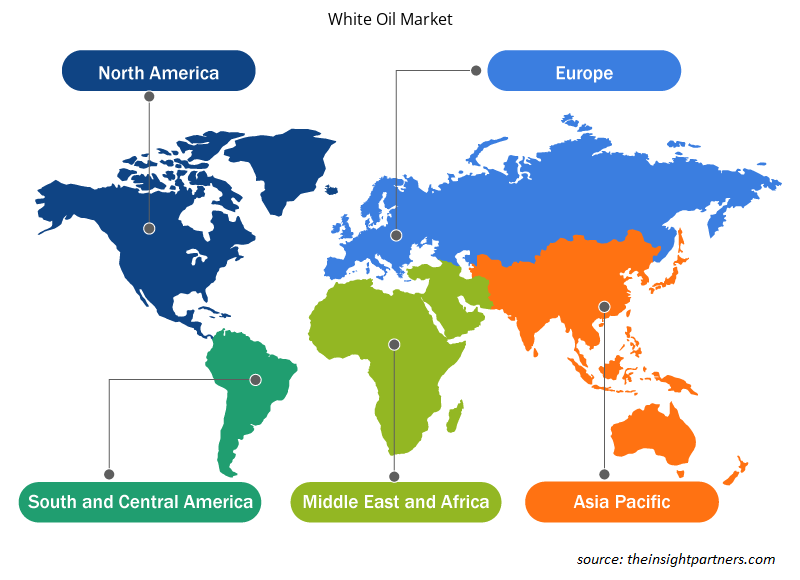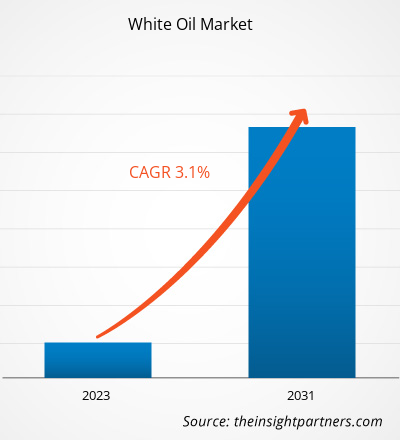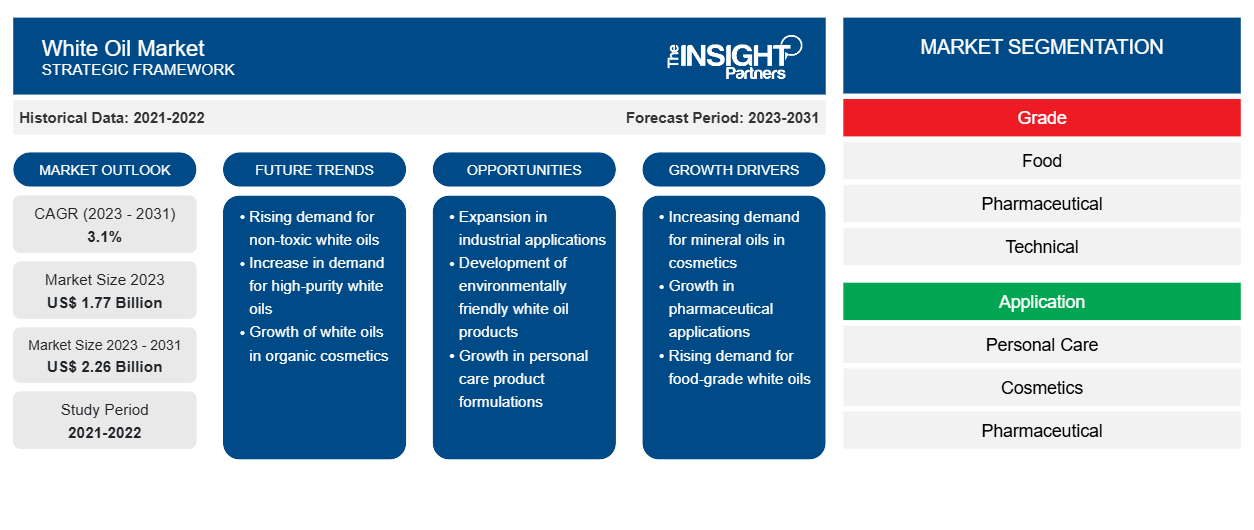La taille du marché de l'huile blanche devrait atteindre 2,26 milliards USD d'ici 2031, contre 1,77 milliard USD en 2023. Le marché devrait enregistrer un TCAC de 3,1 % en 2023-2031. La demande croissante des industries d'utilisation finale, notamment les industries pharmaceutiques et de soins personnels, devrait rester l'une des principales tendances du marché de l'huile blanche.
Analyse du marché du pétrole blanc
L'industrie des soins personnels accorde une importance primordiale à la sécurité et à la pureté des produits. L'évolution des modes de vie des consommateurs, l'augmentation du pouvoir d'achat dans les pays en développement et le développement accéléré d'ingrédients de soins personnels multifonctionnels sont les principaux facteurs contribuant à l'essor de l'industrie des soins personnels et des cosmétiques. Il existe un énorme besoin d'ingrédients de haute qualité, tels que l'huile blanche, en Amérique du Nord et en Europe. Le haut degré de raffinement de l'huile blanche et les mesures de contrôle de qualité rigoureuses en font un choix idéal. Ses propriétés hypoallergéniques et non comédogènes non toxiques garantissent qu'elle peut être incorporée en toute sécurité dans les formulations sans risque de réactions indésirables ou de sensibilité cutanée. Cela correspond à l'engagement de l'industrie à fournir des produits qui répondent aux normes de sécurité les plus élevées pour les consommateurs.
Aperçu du marché du pétrole blanc
L'huile blanche est hautement raffinée pour éliminer les impuretés, ce qui la rend adaptée à une large gamme d'applications où la pureté est essentielle. Elle est souvent utilisée à diverses fins en raison de ses propriétés lubrifiantes, isolantes et hydratantes. Les huiles blanches peuvent être trouvées dans une gamme de produits tels que les cosmétiques, les produits pharmaceutiques, la transformation des aliments et même comme laxatif. Elle est appréciée pour sa capacité à former une barrière protectrice, à assurer la lubrification et à son absence de couleur, de goût ou d'odeur. L'introduction de l'huile blanche sur le marché implique de mettre en évidence sa pureté, sa faible toxicité et son adéquation à ces applications. Il est important de souligner le respect des normes réglementaires et son rôle d'ingrédient polyvalent et inerte. Alors que les industries continuent d'évoluer, la croissance du marché de l'huile blanche reste forte en raison des performances constantes de l'huile blanche. La nature polyvalente de l'huile blanche la positionne comme un composant précieux dans un large éventail d'industries d'utilisation finale, stimulant l'innovation et les progrès dans les formulations de produits et les processus de fabrication. En outre, l'évolution du comportement des consommateurs a un impact positif sur les tendances du marché de l'huile blanche à travers le monde.
Personnalisez ce rapport en fonction de vos besoins
Vous bénéficierez d'une personnalisation gratuite de n'importe quel rapport, y compris de certaines parties de ce rapport, d'une analyse au niveau des pays, d'un pack de données Excel, ainsi que de superbes offres et réductions pour les start-ups et les universités.
-
Obtenez les principales tendances clés du marché de ce rapport.Cet échantillon GRATUIT comprendra une analyse de données, allant des tendances du marché aux estimations et prévisions.
Moteurs et opportunités du marché du pétrole blanc
La forte demande de l'industrie pharmaceutique stimule la croissance du marché de l'huile blanche
Les organismes de réglementation régissant les produits pharmaceutiques imposent l'utilisation d'ingrédients qui sont des réglementations bien établies. Dans l'industrie pharmaceutique, l'huile blanche est utilisée comme support de spray et de pommade, comme adjuvant de capsule et comme agent de démoulage. Le marché pharmaceutique est l'un des marchés à la croissance la plus rapide au monde. Selon Pharmapproach, les États-Unis possèdent la plus grande industrie pharmaceutique au monde en termes de développement de médicaments, de production et de génération de revenus. Selon Investopedia, les États-Unis sont en tête de la recherche et du développement médicaux dans l'industrie pharmaceutique mondiale. Le marché pharmaceutique a également connu une croissance sans interruption en Chine ces dernières années. Les sociétés pharmaceutiques chinoises sont principalement impliquées dans la production de génériques, de médicaments thérapeutiques, d'ingrédients pharmaceutiques actifs et de médicaments traditionnels chinois. Le pays exporte également des produits pharmaceutiques vers d'autres pays du monde, et la forte demande de médicaments génériques renforce les activités d'exportation du pays.
Augmentation de la demande en tant qu'adhésif dans les emballages alimentaires
L'inclination croissante des consommateurs vers les produits emballés en raison d'un changement des habitudes alimentaires et de la transformation des modes de vie peut avoir un impact impératif sur la demande d'huile blanche. L'huile est utilisée dans la production d'adhésifs pour les emballages alimentaires. L'huile minérale blanche technique est autorisée comme additif alimentaire indirect dans une grande variété de matériaux en contact avec les aliments, y compris les adhésifs. Elle est également utilisée comme composant d'agent antimousse dans les emballages en papier et en carton . L'huile blanche est utilisée dans les adhésifs thermofusibles, qui agissent comme diluant pour assurer la transparence du matériau lorsqu'ils sont utilisés dans les cosmétiques ou les emballages alimentaires. La tendance croissante, comme dans les gobelets, les emballages et les ustensiles de restauration, est toute produite avec de l'huile blanche. Elle est utilisée pour assouplir les produits en caoutchouc et en polymère. L'industrie de l'emballage utilise généralement des huiles blanches dans les produits à base de polymères, d'élastomères thermoplastiques, de polyoléfines et de polystyrène, et cet emballage permet de conserver les aliments croustillants. En outre, l'accent croissant mis sur les salles blanches et les emballages hygiéniques des biens de consommation est l'un des principaux facteurs susceptibles d'encourager l'utilisation d'adhésifs à base d'huile blanche dans l'industrie de l'emballage alimentaire.
Analyse de segmentation du rapport sur le marché du pétrole blanc
Les segments clés qui ont contribué à l’élaboration de l’analyse du marché du pétrole blanc sont le processus et l’application.
- En fonction de la catégorie, le marché est divisé en deux catégories : alimentaire, pharmaceutique et technique. Le segment pharmaceutique détenait une part de marché plus importante en 2023.
- En termes d'application, le marché est segmenté en soins personnels et cosmétiques, produits pharmaceutiques et de santé, industries alimentaires, transformation des plastiques , agriculture et autres. Le segment des soins personnels et des cosmétiques détenait la plus grande part du marché en 2023.
Analyse des parts de marché du pétrole blanc par zone géographique
La portée géographique du rapport sur le marché du pétrole blanc est principalement divisée en cinq régions : Amérique du Nord, Asie-Pacifique, Europe, Moyen-Orient et Afrique, et Amérique du Sud et centrale.
La région Asie-Pacifique a connu une industrialisation et une urbanisation rapides, avec l'expansion de secteurs manufacturiers tels que les produits pharmaceutiques, les cosmétiques, les soins personnels et les textiles. Ces industries sont d'importants consommateurs d'huile blanche en raison de ses propriétés polyvalentes, ce qui en fait un ingrédient essentiel dans divers produits et processus. De plus, l'Amérique du Nord bénéficie d'un paysage industriel et économique très développé, ce qui crée une forte demande pour divers produits dans tous les secteurs. Cette demande s'étend à l'huile blanche, qui trouve des applications dans les secteurs pharmaceutique, des soins personnels, de la transformation des aliments, de la fabrication et d'autres secteurs. La forte base industrielle de la région entraîne le besoin d'ingrédients fiables et polyvalents comme l'huile blanche. En outre, le marché américain de l'huile blanche cosmétique est également en croissance en raison de la demande croissante de produits de soins personnels et cosmétiques dans le pays.
Aperçu régional du marché du pétrole blanc
Les tendances et facteurs régionaux influençant le marché du pétrole blanc tout au long de la période de prévision ont été expliqués en détail par les analystes d’Insight Partners. Cette section traite également des segments et de la géographie du marché du pétrole blanc en Amérique du Nord, en Europe, en Asie-Pacifique, au Moyen-Orient et en Afrique, ainsi qu’en Amérique du Sud et en Amérique centrale.

- Obtenez les données régionales spécifiques au marché de l'huile blanche
Portée du rapport sur le marché du pétrole blanc
| Attribut de rapport | Détails |
|---|---|
| Taille du marché en 2023 | 1,77 milliard de dollars américains |
| Taille du marché d'ici 2031 | 2,26 milliards de dollars américains |
| Taux de croissance annuel composé mondial (2023-2031) | 3,1% |
| Données historiques | 2021-2022 |
| Période de prévision | 2023-2031 |
| Segments couverts |
Par niveau
|
| Régions et pays couverts |
Amérique du Nord
|
| Leaders du marché et profils d'entreprises clés |
|
Densité des acteurs du marché : comprendre son impact sur la dynamique des entreprises
Le marché de l'huile blanche connaît une croissance rapide, tirée par la demande croissante des utilisateurs finaux en raison de facteurs tels que l'évolution des préférences des consommateurs, les avancées technologiques et une plus grande sensibilisation aux avantages du produit. À mesure que la demande augmente, les entreprises élargissent leurs offres, innovent pour répondre aux besoins des consommateurs et capitalisent sur les tendances émergentes, ce qui alimente davantage la croissance du marché.
La densité des acteurs du marché fait référence à la répartition des entreprises ou des sociétés opérant sur un marché ou un secteur particulier. Elle indique le nombre de concurrents (acteurs du marché) présents sur un marché donné par rapport à sa taille ou à sa valeur marchande totale.
Les principales entreprises opérant sur le marché du pétrole blanc sont :
- Partenaires de produits spécialisés Calumet, LP
- Chevron Corp
- Société ExxonMobil
- Lubrifiants Petro-Canada Inc.
- Huile Renkert
- Pétrole de l'Atlantique
Avis de non-responsabilité : les sociétés répertoriées ci-dessus ne sont pas classées dans un ordre particulier.

- Obtenez un aperçu des principaux acteurs du marché du pétrole blanc
Actualités et développements récents du marché du pétrole blanc
Le marché du pétrole blanc est évalué en collectant des données qualitatives et quantitatives après des recherches primaires et secondaires, qui comprennent d'importantes publications d'entreprises, des données d'associations et des bases de données. Voici une liste des évolutions du marché du pétrole blanc et des stratégies :
- Hemisphere Limited LLC est fière d'annoncer l'ajout de White Oil Company, un fournisseur leader de services de distribution de carburant en vrac dans la région, situé à Campbellsville, KY. White Oil Company est un fournisseur bien établi de services de distribution de carburant en vrac et de marque Marathon Fuel dans toute la région, situé à Campbellsville, KY. Avec une solide réputation de qualité et de fiabilité, White Oil est devenu un partenaire de confiance pour ses clients de la région. L'entreprise propose une large gamme de produits et de services, notamment de l'essence, du carburant diesel et du mazout de chauffage, ainsi que l'installation et l'entretien de réservoirs de stockage de carburant. Grâce à son expertise et à son orientation client, White Oil a développé une clientèle fidèle et une forte présence dans la région. (Source : Hemisphere Limited LLC, communiqué de presse, 2023)
Rapport sur le marché du pétrole blanc et ses livrables
Le rapport « Taille et prévisions du marché du pétrole blanc (2021-2031) » fournit une analyse détaillée du marché couvrant les domaines ci-dessous :
- Taille du marché et prévisions aux niveaux mondial, régional et national pour tous les segments de marché clés couverts par le périmètre
- Dynamique du marché, comme les facteurs moteurs, les contraintes et les opportunités clés
- Principales tendances futures
- Analyse détaillée des cinq forces de Porter et SWOT
- Analyse du marché mondial et régional couvrant les principales tendances du marché, les principaux acteurs, les réglementations et les développements récents du marché
- Analyse du paysage industriel et de la concurrence couvrant la concentration du marché, l'analyse de la carte thermique, les principaux acteurs et les développements récents
- Profils d'entreprise détaillés
- Analyse historique (2 ans), année de base, prévision (7 ans) avec TCAC
- Analyse PEST et SWOT
- Taille du marché Valeur / Volume - Mondial, Régional, Pays
- Industrie et paysage concurrentiel
- Ensemble de données Excel
Rapports récents
Rapports connexes
Témoignages
Raison d'acheter
- Prise de décision éclairée
- Compréhension de la dynamique du marché
- Analyse concurrentielle
- Connaissances clients
- Prévisions de marché
- Atténuation des risques
- Planification stratégique
- Justification des investissements
- Identification des marchés émergents
- Amélioration des stratégies marketing
- Amélioration de l'efficacité opérationnelle
- Alignement sur les tendances réglementaires























 Obtenez un échantillon gratuit pour - Marché du pétrole blanc
Obtenez un échantillon gratuit pour - Marché du pétrole blanc